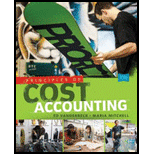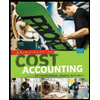
Precision Inc. manufactures wristwatches on an assembly line. The work in process inventory as of March 1 consisted of 1,000 watches that were complete as to materials and 75% complete as to labor and

During the month, 10,000 units were started and 9,500 units were completed. The 1,500 units of ending inventory were complete as to materials and 25% complete as to labor and overhead.
The costs for March were as follows:

Calculate:
- a. Equivalent units for material, labor, and overhead, using the weighted average cost method
- b. Unit costs for materials, labor, and overhead
- c. Cost of the units completed and transferred
- d. Detailed cost of the ending inventory
- e. Total of all costs accounted for
Trending nowThis is a popular solution!

Chapter 6 Solutions
PRINCIPLES OF COST ACCOUNTING
Additional Business Textbook Solutions
Principles of Microeconomics (MindTap Course List)
Horngren's Accounting (12th Edition)
Intermediate Accounting (2nd Edition)
Horngren's Cost Accounting: A Managerial Emphasis (16th Edition)
Operations Management
Operations Management: Processes and Supply Chains (12th Edition) (What's New in Operations Management)
- I need guidance with this financial accounting problem using the right financial principles.arrow_forwardI need help with this general accounting question using the proper accounting approach.arrow_forwardI need help with this financial accounting question using accurate methods and procedures.arrow_forward
- What is the amount of operating cash flowarrow_forwardYamamoto Corporation began the accounting period with $92,000 of merchandise, and the net cost of purchases was $318,000. A physical inventory showed $104,000 of merchandise unsold at the end of the period. The cost of goods sold by Yamamoto Corporation for the period is __. need helparrow_forwardI need help with this general accounting problem using proper accounting guidelines.arrow_forward
- An asset owned by Crescent Manufacturing has a book value of $36,000 on June 30, Year 5. The asset has been depreciated at an annual rate of $8,000 using the straight-line method. Assuming the asset is sold on June 30, Year 5 for $39,500, how should the company record the transaction? a. Neither a gain nor a loss is recognized on this type of transaction. b. A gain on sale of $3,500. c. A gain on sale of $5,000. d. A loss on sale of $3,500. e. A loss on sale of $5,000.arrow_forwardI am looking for help with this general accounting question using proper accounting standards.arrow_forwardCan you explain the correct approach to solve this financial accounting question?arrow_forward
- Jacobson Co. recently reported a net income of $7,840 and depreciation of $1,250. How much was its net cash flow, assuming it had no amortization expense and sold none of its fixed assets? HELParrow_forwardWhat is the value of the ending inventory for the year?arrow_forwardGet correct answer with accountingarrow_forward
 Principles of Cost AccountingAccountingISBN:9781305087408Author:Edward J. Vanderbeck, Maria R. MitchellPublisher:Cengage LearningPrinciples of Accounting Volume 2AccountingISBN:9781947172609Author:OpenStaxPublisher:OpenStax College
Principles of Cost AccountingAccountingISBN:9781305087408Author:Edward J. Vanderbeck, Maria R. MitchellPublisher:Cengage LearningPrinciples of Accounting Volume 2AccountingISBN:9781947172609Author:OpenStaxPublisher:OpenStax College Managerial AccountingAccountingISBN:9781337912020Author:Carl Warren, Ph.d. Cma William B. TaylerPublisher:South-Western College Pub
Managerial AccountingAccountingISBN:9781337912020Author:Carl Warren, Ph.d. Cma William B. TaylerPublisher:South-Western College Pub Financial And Managerial AccountingAccountingISBN:9781337902663Author:WARREN, Carl S.Publisher:Cengage Learning,
Financial And Managerial AccountingAccountingISBN:9781337902663Author:WARREN, Carl S.Publisher:Cengage Learning, Cornerstones of Cost Management (Cornerstones Ser...AccountingISBN:9781305970663Author:Don R. Hansen, Maryanne M. MowenPublisher:Cengage Learning
Cornerstones of Cost Management (Cornerstones Ser...AccountingISBN:9781305970663Author:Don R. Hansen, Maryanne M. MowenPublisher:Cengage Learning Managerial Accounting: The Cornerstone of Busines...AccountingISBN:9781337115773Author:Maryanne M. Mowen, Don R. Hansen, Dan L. HeitgerPublisher:Cengage Learning
Managerial Accounting: The Cornerstone of Busines...AccountingISBN:9781337115773Author:Maryanne M. Mowen, Don R. Hansen, Dan L. HeitgerPublisher:Cengage Learning





